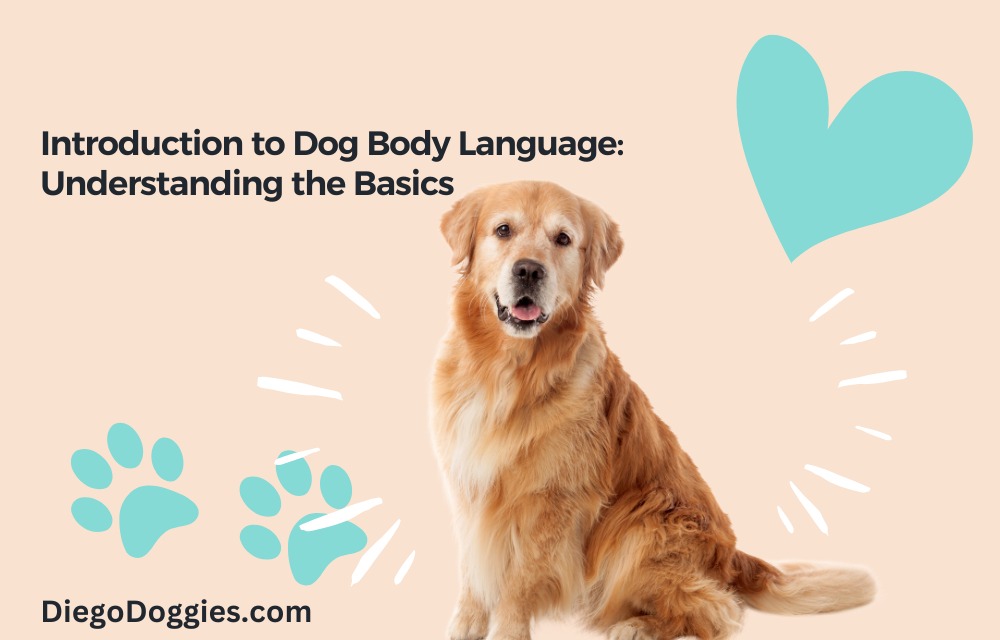Dogs are incredible communicators who use their body language to express a wide range of emotions, needs, and intentions. Understanding dog body language is vital to building a strong bond with your furry friend and creating a safe and happy environment for them.
Dog body language includes various communication tools, such as vocalizations, facial expressions, and body movements. Each tool can convey different messages and emotions, and it’s essential to understand how to interpret them correctly.
In this guide, we will explore the basics of dog body language, including the different types of communication tools used by dogs and how to read and respond to them. We’ll also address some common misconceptions and myths about dog body language and provide practical tips for improving communication with your furry friend.
What is Dog Body Language
Dog body language refers to how dogs communicate their thoughts, feelings, and intentions through physical movements, postures, and vocalizations. Understanding dog body language is crucial for dog owners, trainers, and anyone interacting with dogs.
By interpreting a dog’s body language, we can better understand their emotions, intentions, and potential actions, which can help us prevent conflicts and respond appropriately to their needs.
Definition and Importance
Dog body language includes a variety of signals such as tail position, ear position, eye contact, vocalizations, and body posture. These signals can indicate a range of emotions and intentions, including happiness, fear, aggression, anxiety, and playfulness. By understanding these signals, we can better communicate with our dogs, avoid misunderstandings, and create a stronger bond with them.
Misconceptions and Myths
Several misconceptions and myths about dog body language can lead to misunderstandings and miscommunication between dogs and humans. Some common misconceptions and myths include the following:
1. A wagging tail means a happy dog: While a wagging seat can indicate happiness, it can also show excitement, anxiety, or even aggression, depending on the speed and height of the wag.
2. A growling dog is always aggressive: Growling can be a warning signal, but it can also be a playful vocalization or a sign of fear.
3. A dog that avoids eye contact is submissive: Avoiding eye contact can also indicate fear or anxiety.
It’s important to understand that dog body language is complex and context-dependent and that different dogs may communicate differently based on their breed, temperament, and personal history.

Dog Communication Tools
Dogs use various communication tools to express themselves and interact with other dogs and humans. These communication tools include vocalizations, body movements, and facial expressions.
1. Vocalizations:
Dogs use different vocalizations to communicate their emotions and intentions. Some common vocalizations include barking, growling, whining, and howling. Each vocalization can indicate emotions such as excitement, fear, aggression, or pain. For example, a low, continuous growl may suggest that a dog feels threatened or defensive, while a high-pitched whine may indicate anxiety or distress.
2. Body Movements:
Dogs use body movements to convey information about their emotions, intentions, and social status. Some everyday body movements include tail wagging, ear positioning, and body posture. For example, a high and stiff tail can indicate dominance or aggression, while a low and wagging seat can indicate submission or happiness.
Similarly, erect ears indicate alertness or attack, while flattened ears indicate fear or request. A dog’s body posture, such as standing tall or crouching, can also communicate its emotional state and level of confidence.
3. Facial Expressions:
Dogs use facial expressions to communicate their emotions and intentions as well. Some common facial expressions include squinting, lip licking, and yawning. For example, a dog may blink or show the whites of their eyes when feeling anxious or uncomfortable. A dog may also lick their lips when feeling stressed or uncertain. Similarly, yawning can indicate relaxation or stress.
We can better understand our dogs and respond appropriately to their needs by paying attention to these communication tools. However, it’s important to note that these communication tools can vary between individual dogs and may be influenced by breed, age, and socialization experiences.
The Role of Environment and Context
It’s essential to consider the environment and context in which a dog is exhibiting body language signals. Different settings and situations can elicit other emotions and behaviors in dogs, which can be reflected in their body language.
For example, a dog may exhibit different body language signals when meeting a new dog in a park versus when meeting a familiar dog in their home. In addition, the presence of other dogs or people, the space’s size, and the surroundings’ familiarity can influence a dog’s behavior and body language.
A dog’s past experiences and socialization can also influence its body language. For example, a dog with negative experiences with other dogs may fear or be aggressive when encountering unfamiliar dogs. In contrast, a dog that has been well-socialized may exhibit more simple and friendly body language.
It’s important to consider the environment and context in which a dog exhibits body language signals to interpret their emotions and intentions correctly. By understanding these contextual factors, you can better respond to your dog’s needs and prevent potential conflicts or misunderstandings.
Always prioritize your dog’s safety and well-being, and seek professional help. With proper understanding and attention to environment and context, you can improve communication with your furry friend and build a stronger bond.
Common Dog Body Language Signals and What They Mean
Dogs use various body language signals to communicate their emotions, needs, and intentions. As a result, you can better interpret your dog’s behavior and respond appropriately by understanding these signals. In this section, we’ll explore some of the most common dog body language signals and what they mean, including tail wagging, ear position, body posture, eye contact, vocalizations, licking, and yawning.
Tail wagging: Contrary to popular belief, a wagging tail does not always indicate a happy dog. The tail’s position and the wag’s speed can show different emotions. A tail held high and wagging quickly can indicate excitement or potential aggression, while a low and slow wag can indicate submission or nervousness.
Ears: The position of a dog’s ears can indicate its emotional state. Erect ears indicate alertness or aggression, while flattened ears indicate fear or submission.
Body posture: A dog’s body posture can indicate confidence, comfort, and intentions. A crouched or tense body posture can indicate fear or anxiety, while a relaxed and loose body posture can indicate happiness or comfort.
Eye contact: Direct eye contact can be interpreted as a challenge or threat while avoiding eye contact can indicate fear or submission.
Vocalizations: A dog’s vocalizations indicate its emotional state and potential actions. Growling or barking can warn of possible aggression while whining or whimpering can show fear or distress.
Licking: Licking can be a sign of affection or a way for dogs to calm themselves down in stressful situations.
Yawning: Dogs may yawn to calm themselves down or signal to feel stressed or uncomfortable. Understanding these common dog body language signals allows you to interpret your dog’s emotions better and respond appropriately. Always prioritize your dog’s safety and well-being, and seek professional help.
How to Read and Respond to Your Dog’s Body Language
Reading your dog’s body language is critical to understanding its emotions, needs, and potential actions. Here are some tips on how to read and respond to your dog’s body language:
Observe their body posture: A dog’s posture can indicate confidence, comfort, and intentions. For example, a crouched or tense body posture can indicate fear or anxiety, while a relaxed and loose body posture can indicate happiness or comfort.
Please pay attention to their tail: A dog’s tail position can indicate its emotional state and potential actions. For example, a wagging seat that is held high can show excitement or aggression, while a low and wagging tail can indicate submission or friendliness.
Look at their ears: A dog’s ear position can indicate its level of alertness, comfort, and intentions. For example, erect ears indicate aggression or attention, while flattened ears indicate fear or submission.
Observe their eye contact: A dog’s eye contact can indicate their level of comfort and trust. For example, direct eye contact can be interpreted as a challenge or threat, while avoiding eye contact can show fear or submission.
Listen to their vocalizations: A dog’s vocalizations can indicate its emotional state and potential actions. For example, a growling or barking dog may warn of possible aggression, while a whining or whimpering dog may show fear or distress.
In addition to reading your dog’s body language, responding appropriately to their needs and emotions is essential. For example, if your dog shows signs of fear or anxiety, you may need to remove them from the stressful situation or provide reassurance and comfort. If your dog shows aggression, preventing conflicts and seeking professional help is essential.

Conclusion
Understanding dog body language is essential for building a strong bond with your furry friend and creating a safe and happy environment for them. You can better understand their emotions, needs, and potential actions by learning to read your dog’s communication tools, including their vocalizations, body movements, and facial expressions.
It’s important to note that dog body language can vary between individual dogs and may be influenced by breed, age, and socialization experiences. Therefore, observing your dog’s unique communication style and adjusting your responses is essential.
Responding appropriately to your dog’s body language can strengthen your relationship and prevent potential conflicts or misunderstandings. Always prioritize your dog’s safety and well-being and seek professional help.
FAQ: Introduction to Dog Body Language
Related Content
- How To Tell When Dogs Will Be Aggressive
- The Science Behind Dog Aggression: Causes and Treatment
- 11 Important Tips To Help Your Dog Lose Weight and Become Healthier
- 11 Types of Dog Tails and What They Mean
- 12 Swimming Safety Tips for Your Dog
- 14 Ways to Help Keep Your Dog Happy and Healthy
- 15 Tips to Keep Your Senior Dog Healthy As They Age
- 5 Reasons Why Your Dog Needs a Dog Life Jacket
- A Step-By-Step Guide To Removing A Tick From Your Dog
- Can A Dog Sleep In A Soft Crate
- Collars Versus Harnesses for French Bulldogs
- Cutting a Dog’s Nails: How to Prevent Bleeding
- Dachshund Health Problems and How to Prevent Them
- Demand Barking- 10 Steps to Stop it
- Dog Itchy Skin Home Remedies
- Dog Obesity: How to Help Your Dog Lose Weight and Stay Healthy


